Boeing X-45 / X-46
In the late 1990s, the Defense Advanced Research Projects Agency (DARPA) began to study the possibility of building an unmanned strike aircraft. In March 1999, Boeing received a contract to build two X-45A UCAV (Unmanned Combat Air Vehicle) technology demonstrators. The X-45A was to develop and test technology for a future operational UCAV for ground attack, electronic warfare, surveillance and other operations in high-risk areas. The first X-45A was completed in September 2000, and underwent extensive ground testing, including low- and high-speed taxi tests during 2001 and early 2002. The first flight eventually occurred in May 2002, with the second vehicle following in November that year.
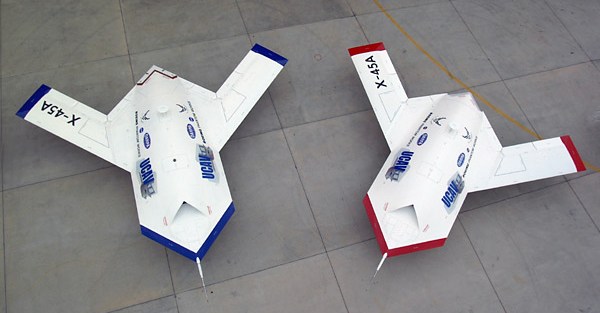 |
| Photo: Boeing |
| X-45A |
The X-45A was a tailless design with low radar and infrared signatures. It was fitted with a conventional tricycle landing gear, and was powered by a single Honeywell F124-GA-100 turbofan engine. In the absence of vertical surfaces, yaw was controlled by a thrust-vectoring system. The aircraft was also equipped with an internal weapons bay of 680 kg (1500 lb) capacity to test all phases of weapons handling and deployment. The X-45A had a GPS-based navigation system, and its primary sensor was an AESA (Active Electronicalls Scanned Array) synthetic aperture radar.
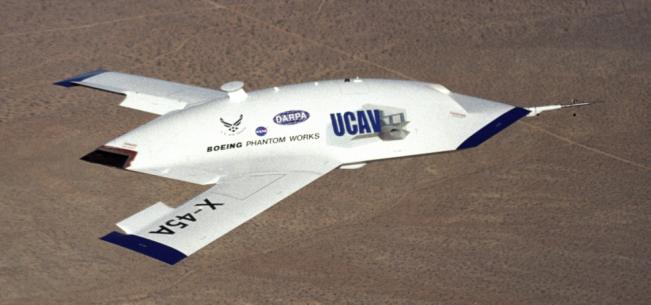 |
| Photo: Jim Ross, NASA |
| X-45A |
As can be expected from an unmanned vehicle which is to operate semi-independently from human operators, a lot of development effort and time went into the flight control software and the required "intelligent" systems for communication and targeting. The software was developed in blocks, and Block 1 testing (which included taxiing, take-off and landing, airborne navigation, and basic communications with the ground control station) was completed in February 2003. Tests of the Block 2 software, which included communication with manned aircraft and the first weapons release, began in November 2003. In March 2004, the X-45A dropped a weapon for the first time, while in April that year, a target was hit with an inert GPS-guided bomb. In August 2004, the two X-45As flew in formation for the first time. Demonstration of the Block 3 software began in October that year, and included, among other features, in-flight mission replanning. The X-45A test program was eventually completed in July 2005, after a total of 64 flights had been successfully completed. The final and most complex mission included detecting and avoiding multiple simulated threats, determining to attack which one of several possible targets, replanning after the operator changed target priorities, and conducting the actual attacks with one or two aircraft.
 |
| Photo: Jim Ross, NASA |
| X-45A |
The X-45A was never intended to represent the final operational UCAV (sometimes referred to as "A-45"). The operational prototype was to be the X-45B, which was originally planned to be available for the U.S. Air Force in the 2006/07 time frame. The X-45B design closely resembled the X-45A, but was somewhat larger to provide greater payload and range. However, before the first X-45B had been built, it was replaced by the larger X-45C (q.v. below), a common basic design for Air Force and Navy requirements.
In parallel with the DARPA/USAF X-45A UCAV effort, the U.S. Navy and DARPA studied a naval carrier-based UCAV under the UCAV-N label. In this case, two contracts for technology demonstrators were awarded in June 2000, to Boeing for the X-46A and to Northrop Grumman for the X-47A. Boeing never disclosed much information on the X-46A, but the overall design was generally similar to the X-45B except for a new wing planform.
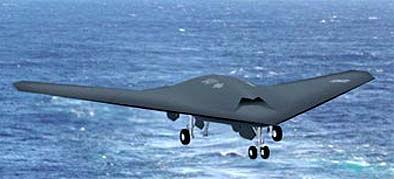 |
| Image: Boeing |
| X-46A |
It soon became evident that the Navy's UCAV-N shared many requirements with the Air Force's UCAV, and that two separate development programs would be a waste of time and resources. In April 2003, the two efforts were formally combined under the joint DARPA/USAF/Navy J-UCAV program, later renamed J-UCAS (Joint Unmanned Combat Air Systems). Both Boeing and Northrop Grumman were developing an aircraft to fulfill the J-UCAS requirement, and flight testing of both systems was expected to begin in 2007. With the creation of J-UCAS, the X-45B and X-46A programs were terminated before any airframe had been built.
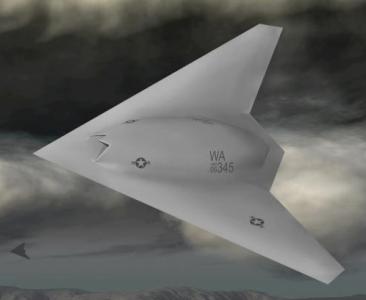 |
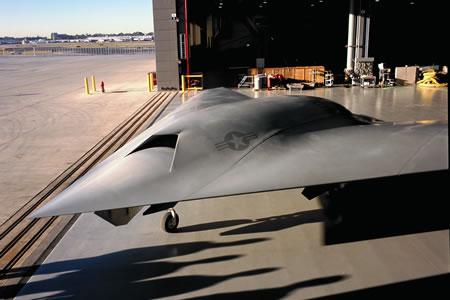 | |
| Image: Boeing | Photo: Boeing | |
| X-45C | X-45C (mock-up) |
Boeing's J-UCAS aircraft was designated X-45C, and effectively combined technology developed under the X-45A program with UCAV-N requirements. The basic center body configuration of the X-45C was similar to the X-45A/B, but the wing planform had changed significantly (it was similar to that of the X-46A). Payload capability was 2040 kg (4500 lb), representing two GBU-31/B JDAM (Joint Direct Attack Munition) GPS/INS-guided bombs. The X-45C was to incorporate provisions for automatic aerial refueling. The special requirements for a carrier-based UCAV in terms of airframe structure and low-speed handling characteristics would probably have led to slightly different X-45C versions for the Air Force and Navy.
The J-UCAS development effort was defined in terms of "spirals" (nothing beats a new buzz-word). The X-45A demonstrator was "Spiral 0", while the X-45C and X-47B represented "Spiral 1". Later spirals were to further enhance the mission capabilities of the system by integrating more sensor and weapon options. The ultimate goal had been labeled J-UOS (J-UCAS Objective System) by DARPA.
In early January 2006, the J-UCAS program was cancelled in favor of separate follow-on programs by the USAF and U.S. Navy, and - in case of the Air Force - the development of new manned long-range bomber aircraft. The Navy has since effectively taken over the J-UCAS program under a new label (first N-UCAS, then UCAS-D (Demonstrator)), and parallel development of the X-47B and X-45C vehicles as carrier-based UCAVs continued until mid-2007. In August 2007, the Navy announced the X-47B as the winner of the UCAS-D competition, and the development of the navalized X-45C (unofficially known as X-45N) was effectively terminated.
Specifications
Note: Data given by several sources show slight variations. Figures given below may therefore be inaccurate!
Data for X-45A/C:
| X-45A | X-45C | |
|---|---|---|
| Length | 8.08 m (26.5 ft) | 11.9 m (39 ft) |
| Wingspan | 10.3 m (33.8 ft) | 14.9 m (49 ft) |
| Height | 1.13 m (3.7 ft) | 1.2 m (4 ft) |
| Weight (gross) | 5530 kg (12190 lb) | 16600 kg (36500 lb) |
| Speed | Mach 0.75 | Mach 0.85 |
| Ceiling | 10700 m (35000 ft) | 12200 m (40000 ft) |
| Mission Radius | 920 km (500 nm) | 2400 km (1300 nm) |
| Propulsion | Honeywell F124-GA-100 turbofan; 28 kN (6300 lb) | General Electric F404-GE-102D turbofan; 31 kN (7000 lb) |
Main Sources
[1] DARPA J-UCAS Website
[2] Jay Miller: "The X-Planes, X-1 to X-45", Midland Publishing, 2001
[3] Boeing Website
[4] Air Force Technology Website
Back to Directory of U.S. Military Rockets and Missiles, Appendix 4
Last Updated: 2 September 2007